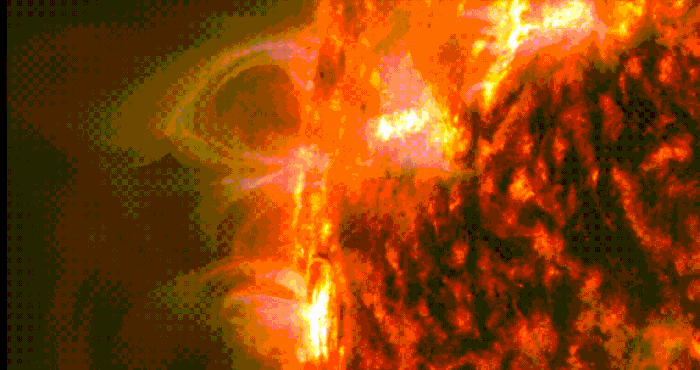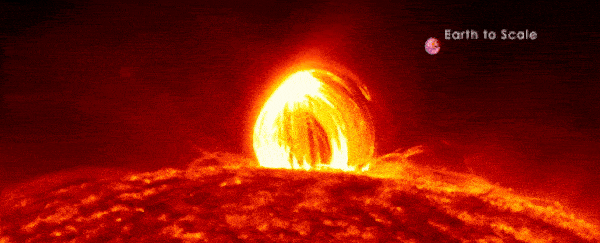It's one of the most enduring mysteries of the Sun: why the superheated surface of this great ball of glowing plasma is actually cooler than its outer atmosphere, called the corona.
Scientists now have a new explanation for this hotly debated topic, and the answer was hidden in a strange solar phenomenon that's never been observed quite like this before: a deluge of plasma rain falling within newly discovered magnetic structures called Raining Null Point Topologies.
On Earth, when it gets hot, water evaporates, turning into steam that lifts into the atmosphere, before cooling effectively reverses the process: water molecules condense inside clouds, which later drop rainfall over the land, oceans, and rivers below.
On the scorching surface of the Sun, a similar cycle of events controls what's known as coronal rain: superheated plasma that traces up from the Sun, often during solar flare events, along invisible magnetic loops.
When this plasma cools as it travels away from the Sun, it forms a kind of fiery rainfall arc, condensing and then descending back down into the photosphere along the paths of these unseen magnetic tracks.
Basically, both Earth and the Sun are similarly subject to showers, just made from different kinds of condensations and cool-downs.
"The physics is literally the same," solar physicist Emily Mason from the Catholic University of America told Science News last year, describing her preliminary research.
Mason's research has now just been published, and it tells us something about coronal rain we never knew: it mostly occurs in an unexpected place, and is associated with a phenomenon new to solar physics.
 Plasma rain in RNTPs (NASA's Solar Dynamics Observatory/Emily Mason)
Plasma rain in RNTPs (NASA's Solar Dynamics Observatory/Emily Mason)
As part of her day job at NASA's Goddard Space Flight Centre, Mason was investigating coronal rain in giant magnetic structures called helmet streamers, which can trace out up to a million miles from the surface of the Sun before looping back to it.
After months of looking for coronal rain in these epic arcs, Mason was unsuccessful, but with the help of data from NASA's Solar Dynamics Observatory (SDO), she did spy much smaller magnetic loops far closer to the photosphere that seemed to display evidence of the plasma rain.
"They were really bright and they kept drawing my eye," Mason says.
"When I finally took a look at them, sure enough they had tens of hours of rain at a time."
Despite the deluge discovered, it was only when Mason shared the data with her fellow NASA researchers that the smaller magnetic structures – which the team calls Raining Null Point Topologies (RNPTs) – were identified as a new solar phenomenon.
"I said, 'Wait…hold on. Where do you see it?'," NASA solar scientist Nicholeen Viall explains. "'I don't think anybody's ever seen that before!'"
According to the researchers, RNPTs occur at altitudes of up to around 50,000 kilometres (30,000 miles) above the Sun's surface. It seems like an immense scale, but compared to the helmet streamers Mason was originally examining, these structures were tiny - just two percent of the streamers' height.
That diminished size could also explain a few things about the corona's intense heat.
"These loops were much smaller than what we were looking for," says one of the team, NASA solar physicist Spiro Antiochos.
"So that tells you that the heating of the corona is much more localised than we were thinking."
The new findings don't tell us exactly how the RNPTs might be heating the corona – which remains hypothetical for now – but the sheer amount of this plasma phenomenon, and its ongoing duration, suggests this could be a big piece of the puzzle.
"The ease with which these structures were identified and the frequency of rain during all observations provides compelling support for the conclusion that this is a ubiquitous phenomenon," the authors explain in their paper.
"In all cases the rain continues for days on what appear to be the same magnetic loops, so it is clearly not a one-shot phenomenon like flare cooling."
Strangely, though, not all the plasma involved in this rain cycle seems to be returned to the Sun.
In the data, the researchers also detected glimpses of a phenomenon called magnetic or interchange reconnection, whereby the plasma on the closed magnetic loop might exit the loop, possibly even contributing to solar wind forces generated by the Sun.
It will take a lot more research and future observations to pin down these possibilities, but the new discovery of RNPTs could be a huge factor in helping scientists to fathom these freaky discrepancies about the Sun's intense heat and plasma flows.
"Since understanding coronal heating is, arguably, the most important unsolved problem in solar physics," the researchers write, "detailed measurements of coronal rain are critically important."
The findings are reported in The Astrophysical Journal Letters.
